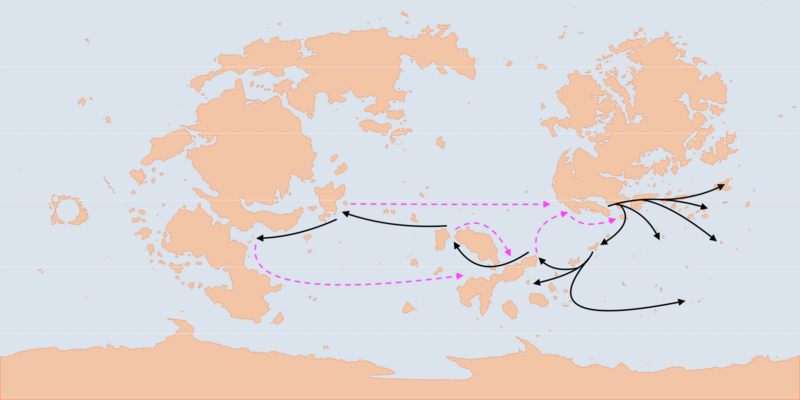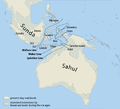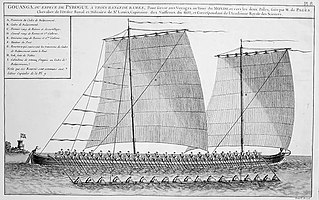Azano-Marenesian peoples
 | |
| Regions with significant populations | |
|---|---|
| Azania, Marenesia | |
| Languages | |
| Azano-Marenesian languages | |
| Religion | |
| Various religions |
The Azano-Marenesian peoples are an ethnically diverse group, found throughout several coastal regions and islands of the Eurth, and originally native to Azania. This group is known for their rich culture, which is deeply influenced by their maritime heritage, and their significant historical migrations that have shaped the demographic composition of several regions on Eurth.
Their history spans several distinct periods. Over time, they developed a range of unique cultural practices, languages, and societal structures. Despite periods of isolation and external influences, the Azano-Marenesian peoples have maintained a strong connection to their ancestral traditions, particularly their reverence for the sea, reflected in their arts, storytelling, and sports like surfing, sailing, and fishing. Today, they continue to contribute to the cultural diversity and richness of the regions they inhabit.
History
Pre-migration
This article or section is in the process of an expansion or major restructuring. You are welcome to assist in its construction by editing it as well. If this article or section has not been edited in several days, please remove this template. If you are the editor who added this template and you are actively editing, please be sure to replace this template with {{in use}} during the active editing session. Click on the link for template parameters to use.
This article was last edited by Orioni (talk | contribs) 10 months ago. (Update timer) |
The earliest mentions of the Azano-Marenesian people date back to the Stone Age, as recorded in the Timeline of Eurth. Archaeological evidence and fossil records indicate that these people were among the first to utilize sophisticated stone tools, demonstrating a deep understanding of their environment and the materials available to them. Rock art found in Azania, dating back to approximately 100,000 years ago, suggests a complex society with an emerging artistic tradition.
Migrations
First migration (80,000 BCE)
The Proto-Marenesians, speakers of the Ayana and Pishatja language isolates, first arrived in the region around 80,000 years ago. Their early settlements were concentrated in the Meteorolas, including the islands of Morimosheku, Maleibidulu and Samberiti, and Paridasei. These early voyages were significant, as they not only demonstrated the seafaring abilities of these early people, but also laid the foundation for the much later Chulo Empire.[a]

BCE
As the Proto-Marenesians expanded their territories, they began to move southwards to San Giorgio and beyond. This expansion was facilitated by lower sea levels during this period, which created land bridges and reduced the distance between islands. The Tata'ina and Doianina islands were among the earliest to be settled during this phase. Meanwhile, Azanians began settling the nearest islands of Morimosheku, gradually supplanting the native Marenesians.
Second migration (50,000 BCE)
The Azano-Marenesian's exploratory spirit led them to follow ocean currents and prevailing winds, leading to the earliest settlement of Marenesia. Cultural and archaeological evidence suggest that some Marenesians travelled west, while others sailed east, diversifying the cultures within the Marenesian civilization.
Third migration (13,000 BCE)
The first voyages to Alharu have left traces that are difficult to date due to the transient nature of these early explorations. However, the earliest dateable evidence of Azano-Marenesian presence in Alharu comes from a site in the southern part of the region, where artefacts associated with the Azano-Marenesian culture have been carbon-dated to approximately 15,000 years ago.
Fourth migration (10,000 BCE)
Coastal explorations of Aurelia and Argis, have yielded a variety of archaeological finds. Settlements, indicating both temporary and long-term habitation, have been uncovered along the coasts. In Aurelia, a site in the southern part of the continent has revealed the remnants of a small village, with carbon dating suggesting it was inhabited around 10,000 years ago. Similarly, in Argis, stone tools and pottery shards, indicative of Azano-Marenesian culture, have been found in various coastal sites, suggesting that these early explorers had indeed made their way to this northern continent.
WIP: inspiration gallery
Later recorded history
Following the prehistoric period, a robust system of Transadlantic trade began to emerge among the Azano-Marenesian peoples.
This commerce piqued the interest of the nearby Memopotamians, who jealously guarded the trade secret of these lucrative routes.
This period of flourishing trade, however, also marked a darker chapter in Azano-Marenesian history. Slavery became widespread, with many Azanians and Marenesians forced into servitude.
In response to this brutal system, Azanians, including numerous runaway slaves, began to form defensive alliances.
These coalitions offered some measure of protection against the slavers and represented the first steps towards collective resistance.
Classical Era
Centuries later, during the Classical Era, news of the prosperous Marenesian islands reached other Europans.
Spurred by tales of wealth and exotic lands, several groups attempted perilous voyages across the vast ocean to Marenesia.
Only a handful of these explorers succeeded.
Among them were the Sokhaineans, who left their homes in Southern Mekabiri to settle in the Southern Meteorolas and Paridasei islands, carving out a new home amidst the Azano-Marenesian civilization.
Simultaneously, the Gomu people from Kotowari ventured into the Marenesian sphere, establishing their settlements in Maleibidulu and Samberiti.
These new arrivals adapted to their new surroundings, blending their traditions with the established Azano-Marenesian cultures.
This period of migration marked the beginning of a significant cultural and demographic shift in Marenesian society, the effects of which are still evident today.
Disconnected Era
The Disconnected Era, a period sandwiched between the prosperous Classical Era and the transformative Age of Reconnection, was characterized by significant changes in the Azano-Marenesian societies. During this era, connections between different regions weakened as sea voyages became less frequent, possibly due to unpredictable climatic changes impacting the reliability of their maritime technology. This resulted in the Azano-Marenesian civilizations becoming more isolated from each other, leading to a divergence in cultural practices and languages. In Azania, the societies that had once been united by shared maritime exploration found themselves splintered into distinct cultural groups. Communities turned inwards, focusing on local resources and developing unique ways of life adapted to their specific environments. Meanwhile, in Marenesia, the decrease in voyages led to a period of relative isolation. The once-connected islands grew more distant, with each developing its own distinct identity. The islanders, undeterred by the isolation, honed their skills in agriculture, fishing, and local craftsmanship, leading to the development of rich, diverse cultures. In the Meteorolas and Paridasei islands, the Sokhaineans adapted to their new environment, incorporating Azano-Marenesian practices into their own culture while also introducing their own traditions. The Gomu in Maleibidulu and Samberiti underwent a similar evolution, blending their Kotowari heritage with the local Azano-Marenesian culture. Despite the lack of broader communication and exchange, this era was not devoid of progress or development. Indeed, the Disconnected Era saw the flourishing of unique, localized cultures, each shaped by the opportunities and challenges of their specific environments. However, as the Disconnected Era drew to a close, the Azano-Marenesian societies would once again feel the pull of the wider world, heralding the beginning of the Age of Reconnection. This renewed interaction would bring both opportunities and challenges, forever changing the course of Azano-Marenesian history.
Age of Reconnection
The Age of Reconnection marked a new era in the history of the Azano-Marenesian peoples, akin to our world's Columbian exchange. During this period, the settlement of Tairona emerged as a notable development. The Tairona were a gentle, pastoral people who held deep respect for Eurth and revered the natural order. They initially inhabited inland valleys, but as population pressure increased and the lure of more fertile lands became irresistible, they were driven to the steep mountain slopes. In these challenging environments, the Tairona demonstrated remarkable ingenuity. They carved platforms for their dwellings and agricultural plots directly into the mountainside, linking them with intricate networks of paths and stairways. Aqueducts were constructed to divert jungle rainfall, irrigating their gardens and maintaining a steady water supply. The landscape of Tairona, thus, evolved into a stunning mosaic of human ingenuity and natural beauty. However, the peaceful existence of the Tairona was disrupted by the arrival of the conquerors, represented by the arrival of the Conquistadors in our world. Despite their fierce resistance, the Tairona were ultimately overrun. Their culture was ruthlessly destroyed, and their settlements were abandoned, leaving the once vibrant mountain terraces to be slowly reclaimed by the jungle.[d] This chapter of the Azano-Marenesian history serves as a poignant reminder of the cultural richness of the past and the devastating impact of colonization on indigenous societies.
Geography
The Azano-Marenesian region, spanning from Azania across Marenesia, is characterized by a diverse array of landscapes and climates, shaped by its position across the equator and influenced by oceanic and weather patterns. The geography of the Azano-Marenesian region is incredibly diverse, reflecting the adaptability and resilience of the Azano-Marenesian peoples who have called these areas home.
Old Wurld
Azania, often regarded as the cradle of the Azano-Marenesian peoples, is a vast subcontinent with varied geographical features. The northern part of Azania is dominated by expansive savannahs and arid deserts, while the central region is characterized by lush rainforests and numerous river systems. The southern part of the continent, meanwhile, is home to cooler, temperate climates and rugged mountain ranges. Azania's western coastline is marked by an intricate system of lagoons and mangrove forests, while its eastern coast features towering cliffs and sandy beaches.
The Meteorolas and Paridasei Islands, located southheast of Azania, boast a tropical climate. These islands are marked by their volcanic origins, resulting in rugged terrain with high peaks, steep valleys, and fertile soils. The coastal areas are lined with beautiful white-sand beaches, while the interiors are home to dense rainforests and crystal-clear freshwater lakes.
Marenesia
Marenesia, located further west, is an extensive archipelago with countless islands, each with its unique geographical traits. Generally, these islands are characterized by lush tropical rainforests, pristine beaches, and vibrant coral reefs. The larger islands are often mountainous, some with volcanic peaks that occasionally become active. The smaller islands tend to be low-lying coral atolls, surrounded by extensive marine ecosystems.
San Giorgio, Tata'ina, and Doianina Islands, situated south of Azania, feature a more temperate climate. These islands are characterized by their rolling hills, fertile plains, and dense forests. The coastal regions offer a mix of sandy beaches and rocky cliffs, while the interiors are interspersed with freshwater lakes and rivers.
New Wurld
Alharu, Aurelia, and Argis, where some Azano-Marenesian explorers ventured, are characterized by their diverse climates and landscapes. Alharu is primarily tropical, with dense rainforests, swamps, and high mountains. Aurelia features vast rainforests in the northwest, arid plains in the center, and cold, mountainous regions in the south. Argis, on the other hand, ranges from frozen tundra in the north, through vast forests and plains in the center, to temperate and !mediterranean (Mediargic?) regions in the south.
Demographics
This article or section is in the process of an expansion or major restructuring. You are welcome to assist in its construction by editing it as well. If this article or section has not been edited in several days, please remove this template. If you are the editor who added this template and you are actively editing, please be sure to replace this template with {{in use}} during the active editing session. Click on the link for template parameters to use.
This article was last edited by Orioni (talk | contribs) 10 months ago. (Update timer) |
The Azano-Marenesian peoples are an ethnically diverse group, with a demographic composition shaped by historical migrations, cultural exchanges, and periods of isolation and reconnection. The Azano-Marenesian peoples represent a rich tapestry of ethnic, linguistic, and religious diversity, evidence of their complex history and enduring adaptability.
Ethnic Composition
The Azano-Marenesian ethnic composition is complex due to centuries of interaction and intermingling. In Azania, the primary ethnic groups include the Azanians, descendants of the original inhabitants of the continent. The Meteorolan people and Paridasei Islanders, who trace their ancestry to the early Proto-Marenesians, represent significant ethnic groups in the Meteorolas and Paridasei Islands.
In Marenesia, the majority ethnic group is the Marenesians, descendants of the Azano-Marenesian explorers who settled the archipelago. Smaller ethnic groups in Marenesia include the Sokhaineans in the southern islands and the Gomu in Maleibidulu & Samberiti, both of whom trace their ancestry back to other parts of Eurth.
On the islands of San Giorgio, Tata'ina, and Doianina, the demographics are primarily made up of a blend of Azanian and Marenesian peoples, reflecting their historical connection with both regions. Lastly, in Alharu, Aurelia, and Argis, small native communities of Azano-Marenesian descent still exist, remnants of the historical voyages from Azania and Marenesia.
Language
The Azano-Marenesian peoples speak a range of languages, reflecting their diverse ethnic composition. In Azania, the dominant languages include various Sahrabic dialects. In the Meteorolas and Paridasei Islands, the Ayana and Pishatja language isolates are spoken, while in Marenesia, the Marenesian language family is widespread. The Sokhaineans and Gomu maintain their own languages, Sokhainean and Gomu, respectively.
WIP
- Languages. Any similarities? Ask User:TheRandomHat for help.
Religion
Religious beliefs among the Azano-Marenesian peoples are diverse, with animistic and ancestor worship practices being common. However, many have also adopted world religions like Christianity and Salam, especially in areas with historical foreign influence.
WIP
- Religion. Any remaining traditions?
Culture
The Azano-Marenesian peoples' culture is a vibrant blend of tradition and adaptation, profoundly influenced by their relationship with the sea. This is deeply rooted in their respect for nature and the sea. This is reflected in their arts, music, dance, and storytelling, which often portray themes of the sea, navigation, and the natural world. Their traditional music employs various indigenous instruments, and their dances are vibrant expressions of their historical narratives and spiritual beliefs. Their art forms are diverse and include intricate wood carving, pottery, textile weaving, and body art. Storytelling is a cherished tradition, with myths, legends, and historical tales passed down through generations orally. These stories often incorporate elements of their belief systems, ethical values, and ancestral knowledge about their environment.
Sports and recreational activities reflect their deep connection with their maritime environment, a symbol of their enduring heritage. Surfing, sailing, and fishing are not only practical skills but also form an integral part of their cultural practices. Surfing has been a traditional pastime for the Azano-Marenesian peoples. It is seen as a harmonious interaction with the ocean, and the mastery of surfing is highly respected. Traditional surfboards are often handcrafted, and the process of making and maintaining these boards is considered an important skill. Sailing is another significant aspect of Azano-Marenesian culture. The ability to navigate the vast oceans using traditional methods is highly revered. Sailing competitions and festivals are common, with large outrigger canoes often used for these events. These occasions are not only sporting events but also cultural gatherings, where traditional navigation knowledge is passed down and celebrated. Lastly, Fishing is not only a crucial source of sustenance but also a popular recreational activity. Traditional fishing methods, using handmade nets, lines, and traps, are still practiced and taught to younger generations. Fishing competitions are also common, promoting camaraderie and showcasing skills.
See also
References
Notes
- ↑ OOC. Remove and/or replace mentions related to Safiloa, since they're no longer an active member of the Eurth RP community.
- ↑ OOC. Borrowed from the Olmec alternative origin speculations.
- ↑ OOC. Borrowed from the Pre-Columbian transoceanic contact theories.
- ↑ OOC. Inspired by ‘La Ciudad Perdida, the Lost City of the Tairona first nation, modern Colombia’ on Reddit. https://redd.it/xw9yks




![Olmec head.[b]](https://upload.wikimedia.org/wikipedia/commons/thumb/9/94/San_Lorenzo_Monument_3.jpg/120px-San_Lorenzo_Monument_3.jpg)






